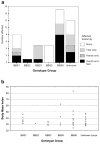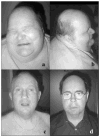Clinical and genetic epidemiology of Bardet-Biedl syndrome in Newfoundland: a 22-year prospective, population-based, cohort study
- PMID: 15637713
- PMCID: PMC3295827
- DOI: 10.1002/ajmg.a.30406
Clinical and genetic epidemiology of Bardet-Biedl syndrome in Newfoundland: a 22-year prospective, population-based, cohort study
Abstract
Bardet-Biedl syndrome (BBS) and Laurence-Moon syndrome (LMS) have a similar phenotype, which includes retinal dystrophy, obesity, and hypogenitalism. They are differentiated by the presence of spasticity and the absence of polydactyly in LMS. The aims of this study were to describe the epidemiology of BBS and LMS, further define the phenotype, and examine genotype-phenotype correlation. The study involved 46 patients (26 males, 20 females) from 26 families, with a median age of 44 years (range 1-68 years). Assessments were performed in 1986, 1993, and 2001 and included neurological assessments, anthropometric measurements, and clinical photographs to assess dysmorphic features. The phenotype was highly variable within and between families. Impaired co-ordination and ataxia occurred in 86% (18/21). Thirty percent (14/46) met criteria for psychiatric illness; other medical problems included cholecystectomy in 37% (17/46) and asthma in 28% (13/46). Dysmorphic features included brachycephaly, large ears, and short, narrow palpebral fissures. There was no apparent correlation of clinical or dysmorphic features with genotype. Two patients were diagnosed clinically as LMS but both had mutations in a BBS gene. The features in this population do not support the notion that BBS and LMS are distinct. The lack of a genotype-phenotype correlation implies that BBS proteins interact and are necessary for the development of many organs.
(c) 2005 Wiley-Liss, Inc.
Figures






References
-
- Ansley SJ, Badano JL, Blacque OE, Hill J, Hoskins BE, Leitch CC, Kim JC, Ross AJ, Eichers ER, Teslovich TM, Mah AK, Johnsen RC, Cavender JC, Lewis RA, Leroux MR, Beales PL, Katsanis N. Basal body dysfunction is a likely cause of pleiotropic Bardet–Biedl Syndrome. Nature. 2003;425:628–633. - PubMed
-
- Anthony A, Bogle D, Ingram TTS, McIsaac MW. The Edinburgh Articulation Test. London: E&S Livingstone; 1971. pp. 7–30.
-
- Bardet G. Sur un syndrome d’obesite congenitale avec polydactylie et retinite pigmentaire (contribution a l’etude des formes cliniques de l’obesite hypophysaire) These de Paris (Le Grand) 1920;470:107.
Publication types
MeSH terms
Substances
Grants and funding
LinkOut - more resources
Full Text Sources
Miscellaneous

